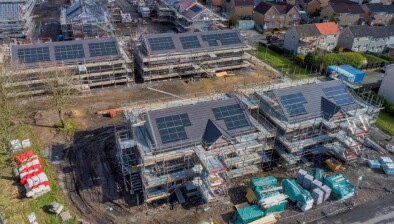Blog: Community-led housing initiatives in the Hebrides

Shaz Morton and Andrew Prendergast from think tank and advocacy group Common Weal describe the key aspects of community-led housing and look at two initiatives in the Highlands & Islands that are putting the principles into practise.
Last month Common Weal Skye held the third in a series of events focussing on rural regeneration and housing in the Highlands & Islands. We were delighted to welcome two speakers; Agnes Rennie of Urras Oighreachd Ghabhsainn (Galson Estate Trust) on the Isle of Lewis, and Andrew Prendergast, Isle of Skye-based rural development practitioner.
Andrew is currently organising a housing needs survey of his local community on Skye’s Sleat peninsula. It is hoped that the survey will give the community a clearer picture of the scale, type and urgency of the need for affordable housing in their area. This will be invaluable in shaping a community-led housing initiative for Sleat, an area where a quarter of the housing stock is holiday lets and second homes, and incomes are 10% below the Scottish average.
Andrew gave an overview of community-led housing models which he hopes will inspire more pro-activity in the Highlands & Islands:
Community-led housing (CLH) is a movement which is currently attracting a lot of attention throughout the UK. A broad church, it covers a wide range of alternative housing models from rental co-operatives, and mutual equity homeownership to collective self-build and commissioning.
Community-led housing is a way for communities to provide affordable homes that meet specific local needs. It may be designed to help certain groups – young people, older people, or those in need of affordable family homes. It’s often eco-friendly and sustainable. Crucially it differs from the ‘standard’ social housing as provided by housing associations and councils in being co-designed by and for a particular group of local people. It includes alternative housing models that offer a ‘third way’ between the private market, and public provision.
Broadly speaking the features which define CLH models are;
Community-led housing should not displace or duplicate the provision of social housing by RSL’s (Registered Social Landlords like housing associations) where it exists. However, in many of the remoter areas of rural Scotland, there has been little or no provision of social housing for decades. Even where RSLs are active, there is a role for communities to facilitate the creation of housing types and tenures which mainstream social housing does not fulfil.
A brief overview of just some of these might include:
These are just some of the innovative options possible under the banner of community-led housing and they offer people affordable alternatives to the stark choice between renting and being a ‘slave’ to a 25 year mortgage. A small number of pioneering grass-roots groups are beginning to explore these models in Scotland, but there is scope for an awful lot more activity to address the crisis in affordable rural housing. Community empowerment and the ownership of land assets presents an opportunity for rural communities to encourage and facilitate more of these exciting initiatives.
Our second speaker, Agnes Rennie then described just how the communities of the Galson Estate in North-West Lewis had used these powers to buy out their crofting lands in 2007. This created Urras Oighreachd Ghabhsainn (www.galsontrust.com) – a community landlord, but nevertheless one which must work in partnership with the 22 crofting townships which make up the estate.
Immediately upon purchase the Trust became responsible for 56,000 acres of inby croft land and common grazings, which generated very little income and had limited potential to do so. They quickly identified renewable energy as a potential source of significant income, and by 2015 had managed to erect three 900kW turbines at a total cost of £5 million. The investment was raised through a mixture of commercial bank lending and a local share offer which raised £705,800 from 167 investors. The Baile an Truiseil development is now producing an average annual surplus of £415,000 after loan repayments and share interest.
Having secured a significant source of income for their community, the Trust needed to identify the key priorities for investment over the coming years. During 2015-16 they undertook an extensive consultation process within the community which has resulted in a 20 year strategic plan. The plan identifies three key priorities for investment;
It is under the priority of elderly care that Galson Trust is proposing a ground-breaking development in community-led housing initiatives. Early discussions have taken place with key partners and the Trust is optimistic that the resulting development will meet a number of community aspirations. This innovative proposal could well become a blue-print for the future of community based social care in remote and rural areas of the Highlands.
This article was originally published by CommonSpace.









